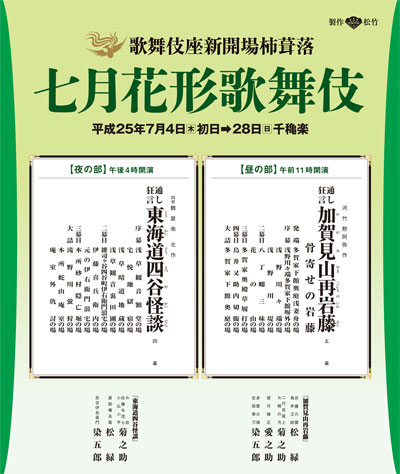| JULY 2013 |
|
4 shows in T˘ky˘ (Kabukiza, National Theatre, Akasaka Act Theater), 2 in ďsaka (Sh˘chikuza), and 2 tours (Eastern Provinces, Central Provinces)!
|
| Kabukiza (T˘ky˘) |  |
| Dates | 4 ~ 28 July 2013 (Kokera Otoshi Shichigatsu Hanagata Kabuki) Opening Ceremony July Young Actors Kabuki |
| MatinÚe | |
| Evening | |
| Casting |
Onoe Kikunosuke, Kataoka Ainosuke, Ichikawa Somegor˘, Onoe Sh˘roku, Ichikawa Danz˘, Kataoka Ichiz˘, Matsumoto Kingo, Ichimura Manjir˘, Kawarasaki Gonjűr˘, Nakamura Matsue, Band˘ Kamesabur˘, Band˘ Kametoshi, Nakamura Baishi, Nakamura Kazutar˘, Onoe Matsuya, Onoe Ukon, ďtani Hirotar˘, ďtani Hiromatsu, Nakamura Tamatar˘ |
| Comments |
4th month celebrating the opening of the new Kabukiza within a 1-year long cycle of kokera otoshi programs. Two spectacular dramas full of keren with young stars!
|
 |
| Sh˘chikuza (ďsaka) |
| Dates | 4 ~ 28 July 2013 (Kansai Kabuki o Ai Suru Kai Shichigatsu ďkabuki) The 22nd Kansai Kabuki Lovers Society July Grand Kabuki |
| MatinÚe |
Yanagikage Sawa no Hotarubi |
| Evening | |
| Casting |
Kataoka Nizaemon, Nakamura Hashinosuke, Nakamura Kanjaku, Kataoka Gat˘, Nakamura Senjaku, Nakamura Fukusuke, Kataoka Takatar˘, Kataoka Hidetar˘, Kataoka Shinnosuke, Kamimura Kichiya, Band˘ Shinsha, Kataoka Kamez˘, Nakamura Kikaku, ďtani Keiz˘, Nakamura Kotar˘ |
| Comments |
22nd edition of the Kansai Kabuki Lovers Society July Grand Kabuki in ďsaka.
|
 |
| National Theatre (T˘ky˘) |
| Dates | 3 ~ 24 July 2013 (Shichigatsu Kabuki Kansh˘ Ky˘shitsu) July Kabuki Appreciation Class |
| Program | |
| Casting |
Nakamura Tokiz˘, Ichikawa Unosuke, Ichimura Kakitsu, Band˘ Shűch˘, Nakamura Mantar˘ |
| Comments |
Educational program at the National Theatre called Kabuki Kansh˘ Ky˘shitu ("Kabuki Appreciation Class"). This is a very interesting formula for the beginners because there is lively presentation of Kabuki (or some aspects of the art like music, stage tricks or fighting scenes) on stage, followed by the drama "Kuzu-no-Ha".
|
| Kabuki Tour in the central provinces | |
| Dates | 1 ~ 29 July 2013 (Sh˘chiku ďkabuki) Sh˘chiku Grand Kabuki |
| Program | |
| Casting |
Nakamura Kichiemon, Nakamura Shibajaku, Nakamura Matagor˘, Nakamura Kash˘, Nakamura Kinnosuke, Nakamura Karoku, Nakamura Tanenosuke, Nakamura Hayato, Nakamura Yonekichi |
| Comments |
Nakamura Matagor˘ III and his son Nakamura Kash˘ IV celebrate their shűmei touring in the central provinces!
|
| Kabuki Tour in the Eastern Provinces | |
| Dates | 1 ~ 29 July 2013 (Sh˘chiku ďkabuki) Sh˘chiku Grand Kabuki |
| Program | |
| Casting |
Ichikawa Ennosuke, Nakamura Baigyoku, Ichikawa Monnosuke, Ichikawa Ukon, Ichikawa Emisabur˘, Ichikawa Emiya, Ichikawa Shun'en, Ichikawa En'ya, Ichikawa K˘tar˘, Ichikawa Juen |
| Comments |
Ichikawa Ennosuke IV celebrates his shűmei touring in the eastern provinces!
|
| Akasaka Act Theater (T˘ky˘) |  |
| Dates | 4 ~ 28 July 2013 (Band˘ Tamasabur˘ Tokubetsu K˘en) Band˘ Tamasabur˘ Special Performances |
| Program |
Amaterasu |
| Casting | |
| Comments |
Living National Treasure Band˘ Tamasabur˘ and the Kod˘ taiko drummers revive "Amaterasu", which was staged for the first time in May 2006 at the Minamiza [more details]. |
|
|
| Contact | Main | Top | Updates | Actors | Plays | Playwrights | Programs | Links | FAQ | Glossary | Chronology | Illustrations | Prints | Characters | Derivatives | Theaters | Coming soon | News |